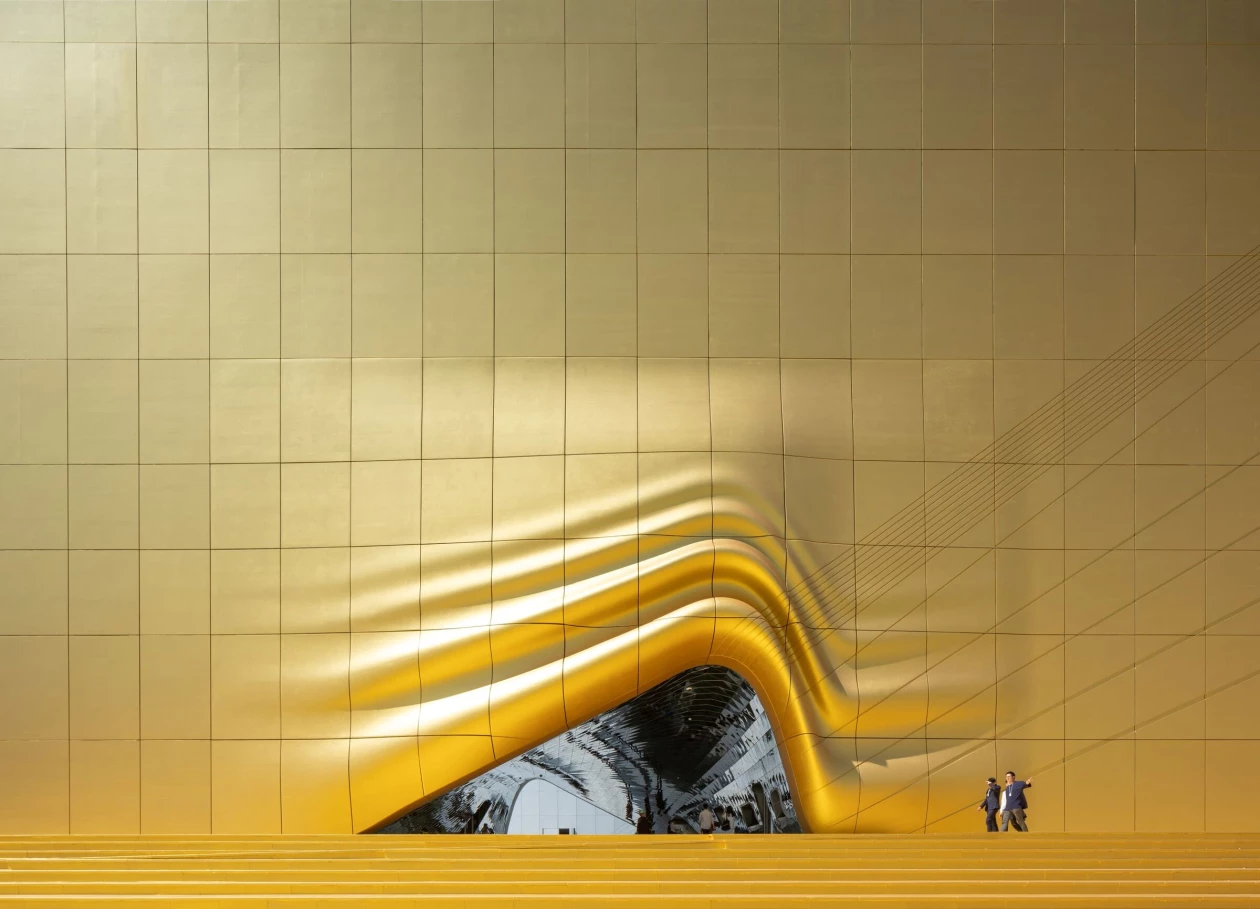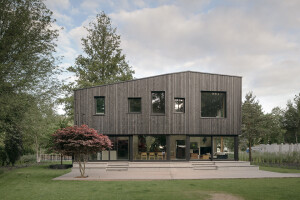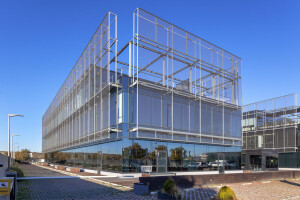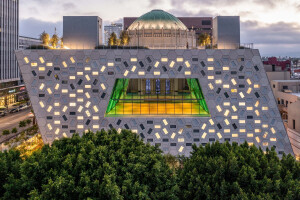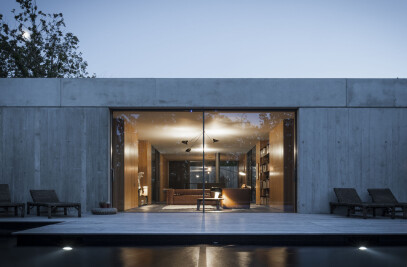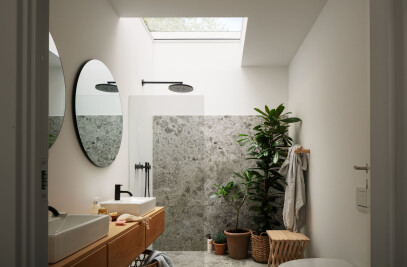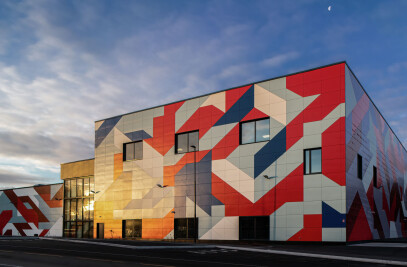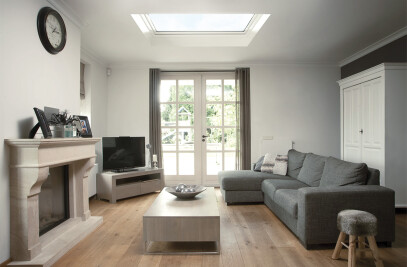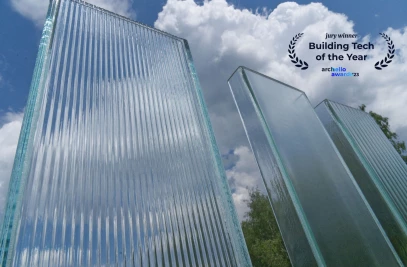Glass Fiber Reinforced Concrete (GFRC or GRC) is a lightweight, durable composite of cement reinforced with glass fibers. It can be hand- or machine-cast into strong yet thin panels using molds with an increasing diversity of curved and flat shapes and sizes, colors, textures and finishes. GFRC cladding can help buildings to achieve a monolithic character, while individual panels can be detailed to offer rich textures and forms that give a level of visual and technical intricacy to building envelopes.
Powder pigments may be used within GFRC mixes to achieve specific color effects. Paints and sealers can also be applied to GFRC for either increased protection or a wider range of color choices. Clear coatings may be applied to panels to reduce moisture movement along the surfaces of the otherwise porous material. And panels can also be polished to offer varying degrees of reflectivity.
Typically applied as a rainscreen system, GFRC panels are most often mounted by brackets to a building's sealed envelope or structure, protecting it from the elements while allowing for drainage and evaporation. GFRC is an excellent alternative to ceramic, concrete, terracotta and other solid-panel cladding systems.
The Audrey Irmas Pavilion by OMA is clad in 1,230 GFRC panels, unitized and hexagonal in shape and inset with a rectangular window at various angles of rotation. The panels are aggregated to create a strong patterning across the facade of this monolithic structure. The GFRC panels are water-blasted and textured, with tones chosen for their similarity to the finishes of the existing adjacent temple.
The Heydar Aliyev Center by Zaha Hadid Architects consists of 3,150 panels of GFRC produced by Arabian Profile which cover 10,000 square meters of surface and feature single, double and even triple-curved forms. Each panel features an identifying microchip containing all information relating to that specific panel. The cladding closely follows the building's complex curved geometry and allows it to read as a continuous volume that transitions from the planar surface of the surrounding plaza. The panel joints run parallel and reinforce the building's curvature.
The Art Deco Project by Aranda/Lasch features a facade of molded GFRC panels which form patterns inspired by the pleating found in Miami's Art Deco architecture and fashion. The panels fan out above the building's street level retail to create angular recessed storefront coffers. The pattern subtly fluctuates based on the program within, and is enhanced by lighting integrated into the panel joints.
4. Multi-Sport Pavilion and Classroom Complex
The Multi-Sport Pavilion and Classroom Complex for Francisco De Vitoria University was designed by Alberto Campo Baeza . Its southern facade as well as other surfaces with the most exposure to sunlight are clad in large, planar GFRC panels which, according to the architect, help the building to achieve visual sobriety and formal restraint. The underlying structure for the sports pavilion is constructed in reinforced concrete.
5. The Veil
The Veil by Archea Associati is a five-story hotel in Astana, Kazakhstan. It is clad in GFRC which functions as a visually vibrating system of vertical lamellas, like drapes and pleats of fine fabrics moving in the wind. The pigmented panels are combined with a palette of wood and corten steel to contrast with glass surfaces. The solidity of the cladding features varying gradients of cuts to permit natural light to penetrate the interior spaces.
6. The Goodtime
The Goodtime by Morris Adjmi Architects is an adaptive reuse project for a hotel in Miami’s South Beach Art Deco Historic District. The building’s tower and entry are clad in fluted GFRC panels manufactured by GFRC Cladding System, LLC. The flutes that compose the facade are a modern reinterpretation of the scale and rhythm of the pilasters visible on many of the surrounding neighborhood’s historic facades.
7. The Imprint at Paradise City
The Imprint at Paradise City, an entertainment and hospitality complex in Seoul by MVRDV, is clad in an envelope that projects the designs of the immediate surrounding building facades. These are ‘draped’ over the simple building forms and plazas like a shadow, and imprinted as a relief pattern using 3,869 GFRC panels with several unique molds. The panels are painted white to emphasize relief.
8. Arter Koç Foundation Contemporary Arts Museum
The Arter Koç Foundation Contemporary Arts Museum, designed by Grimshaw, features a solid volume that houses exhibition galleries clad in 1200 panels of GFRC produced by Fibrobeton . Convex and concave rhomboid-shaped panels create a dramatic and inviting envelope, and reflect the sun as it moves across the museum throughout the day. The rich palette of changing light and shadow animates the building and provides an engaging and contemporary reinterpretation of Istanbul's historic mosaic facades.
LAND Community Center by EID Architecture uses GFRC to clad the sculptural base of the building, in contrast to its glazed upper volume. According to the architect, a combination of digital fabrication with local crafts were experimented to produce the precast GFRC panels, which are shaped to create a dynamic surface rippling effect.
10. Prior Performing Arts Center
The Prior Performing Arts Center by Diller Scofidio + Renfro is clad in large-format GFRC panels produced by cladding manufacturer David Kucera and which twist in relation to the facade. The GFRC cladding is paired with weathering steel to offer contrasts in texture and highlight the effect of two interlocking forms, providing a fluid transition between walls and roofs.
